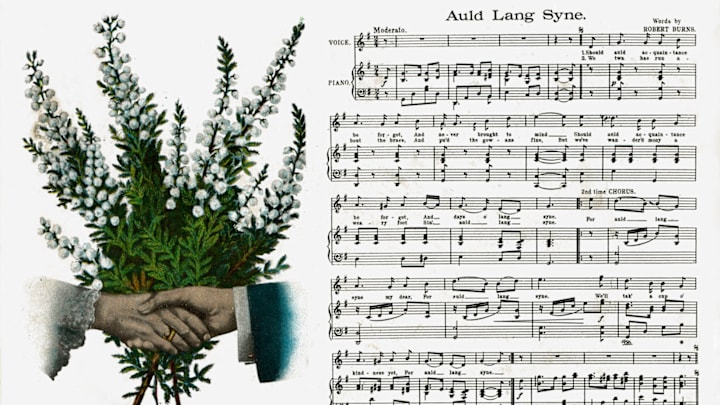Every New Year’s Eve, after the champagne has been popped, the ball has dropped, and everyone is feeling very merry indeed, revelers queue up the same song they’ve been queuing up for decades. You know the one—it makes you cry, even though you don’t understand it and know almost none of the words.
A handful of options pop up when you search for the meaning of auld lang syne: “times/days gone by,” “old time’s sake,” “long long times/ago,” and even “once upon a time” among them. The most common consensus is something like “for old time’s sake,” which is about as direct an interpretation as you can get, as the word-for-word translation is “old long since.” The line about “for auld lang syne” is essentially, “for (the sake of) old times.” (For the record, it never says the totally nonsensical “for the sake of auld lang syne.”) Beyond the words themselves, there’s even less agreement about exactly how the tune came to be a New Year’s Eve tradition.
For Old Time’s Sake
The song originated as a poem, but it probably wasn’t written by Robert Burns as is commonly believed—at least not entirely. The poet was simply the first person to write down an old Scottish folk song (it bears more than a passing resemblance to “Old Long Syne,” a ballad that was printed by James Watson in 1711). Burns himself said, “I took it down from an old man,” and whether it was transcribed or co-authored, it’s safe to say that the “Auld Lang Syne” we know today is some combination of an old poem and Burns’s creative input.

In any case, Burns sent a copy of the poem to a friend in 1788 and wrote: “There is more of the fire of native genius in it than in half a dozen of modern English Bacchanalians!” Later he contributed it to the Scots Musical Museum.
Five years later, Burns wrote to James Johnson, who was assembling a book of old Scottish songs: “The following song, an old song, of the olden times, and which has never been in print, nor even in manuscript until I took it down from an old man.”

It’s unclear whether Johnson linked Burns to the song in his credits, but by the time the book was published in 1796, the poet was dead. He’d never know that those words would eventually help secure his own cultural immortality.
Name That Tune
The words aren’t the only element that evolved over the years; it’s believed that the original tune is different than the one we drunkenly hum along to today. Originally, the song had a more traditional folk sound, one that can be heard in (of all things) 2008’s Sex and the City movie. This version is still performed today, but with much less frequency than the New Year standard. The melody we all know was used at the suggestion of music publisher George Thompson.

How, then, did a Scottish folk song with a murky provenance and nothing at all to do with New Year’s Eve become associated with the holiday? It’s largely thanks to bandleader Guy Lombardo. In 1929, Lombardo and his band played “Auld Lang Syne” as transitional music while performing at New York City’s Roosevelt Hotel during a New Year’s Eve broadcast. It was played just after midnight, and heard over radio and television airwaves.
A Global Tradition
Today, “Auld Lang Syne” is one of the most recognizable songs around the world, where it’s played at funerals, at celebrations, and as a warning that closing time is approaching at stores throughout Japan.
To impress your date this New Year’s Eve, learn the correct words here—and don’t worry too much about the meaning. As Sally Albright says in When Harry Met Sally...: “Anyway, it’s about old friends.”
Discover More Fascinating Stories About Music:
A version of this story ran in 2018; it has been updated for 2024.
